本博文是学习黑马程序员C++视频时做的笔记,记录一下只是方便温故知新,不做其他用途。
一、string容器
1.1 string基本概念
1、本质:
string是C++风格的字符串,而String本质是一个类
2、string与char*区别:
(1)char* 是一个指针;
(2) string是一个类,内部封装了char*,管理这个字符串,是一个char*型的容器。
3、特点:
string内部封装了很多方法
例如:查找find,拷贝copy,删除delete,替换replace、插入insert;
string管理char*所分配的内存,不用担心复制越界和取值越界等,由类内部进行负责。
1.2 string构造函数
构造函数原型:
- string(); //创建一个空的字符串 例如string str;
- string(const char* s); //使用字符串s初始化;
- string(const string& str); //使用一个string对象初始化另一个string对象;
- string(int n,char c); //使用n个字符c初始化;
示例:
#include <iostream>
using namespace std;
#include <string>
//string构造
void test01()
{
//string();//创建一个空的字符串 例如string str;
string s1; //创建空字符串,调用无参构造函数
cout << "str1 = " << s1 << endl;
//string(const char* s);//使用字符串s初始化;
const char* str = "hello world";
string s2(str); //把c_string转换成了string
cout << "str2 = " << s2 << endl;
//string(const string& str)//使用一个string对象初始化另一个string对象;
string s3(s2); //调用拷贝构造函数
cout << "str3 = " << s3 << endl;
//string(int n,char c);//使用n个字符c初始化;
string s4(10, 'c');
cout << "str4 = " << s4 << endl;
}
int main()
{
test01();
return 0;
}
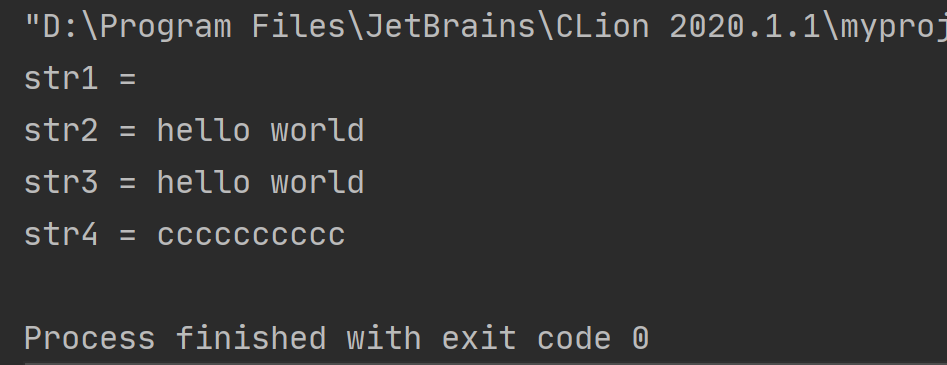
1.3 string赋值操作
功能描述:给string字符串进行赋值。
函数原型:
- string& operator=(const char* s); //char*类型字符串 赋值给当前的字符串
- string& operator=(const string &s); //把字符串s赋给当前的字符串
- string& operator=(char c); //字符赋值给当前的字符串
- string& assign(const char *s); //把字符串s赋给当前的字符串
- string& assign(const char *s, int n); //把字符串s的前n个字符赋给当前的字符串符串结尾
- string& assign(const string &s); //把字符串s赋给当前字符串
- string& assign(int n, char c); //用n个字符c赋给当前字符串
示例:
#include <iostream>
using namespace std;
#include <string>
//string 的赋值操作
void test01()
{
// string& operator=(const char* s); //char*类型字符串 赋值给当前的字符串
string str1;
str1 = "hello world!";
cout<<"str1="<<str1<<endl;
// string& operator=(const string &s); //把字符串s赋给当前的字符串
string str2;
str2 = str1;
cout<<"str2="<<str2<<endl;
// string& operator=(char c); //字符赋值给当前的字符串
string str3;
str3 = 'a';
cout << "str3 = " << str3 << endl;
// string& assign(const char *s); //把字符串s赋给当前的字符串
string str4;
str4.assign("hello c++");
cout << "str4 = " << str4 << endl;
// string& assign(const char *s, int n); //把字符串s的前n个字符赋给当前的字符串
string str5;
str5.assign("hello c++",5);
cout << "str5 = " << str5 << endl;
// string& assign(const string &s); //把字符串s赋给当前字符串
string str6;
str6.assign(str5);
cout << "str6 = " << str6 << endl;
// string& assign(int n, char c); //用n个字符c赋给当前字符串
string str7;
str7.assign(5, 'c');
cout << "str7 = " << str7 << endl;
}
int main()
{
test01();
return 0;
}
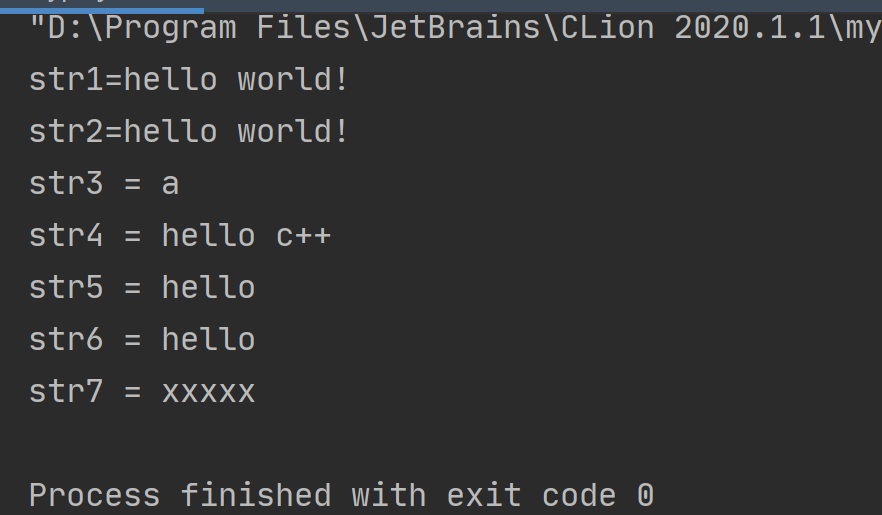
1.4 string字符串拼接
功能描述:
实现字符串末尾拼接字符串。
函数原型:
- string& operator+=(const char* str); //重载+=操作符
- string& operator+=(const char c); //重载+=操作符
- string& operator+=(const char* str); //重载+=操作符
- string& append(const char *s); //把字符串s连接到当前字符串结尾
- string& append(const char *s, int n); //把字符串s的前n个字符连接到当前字符串结尾
- string& append(const string &s); //同operator+=(const string& str)
- string& append(const string &s, int pos, int n); //字符串s中从pos开始的n个字符连接到字符串结尾
示例:
#include <iostream>
using namespace std;
#include <string>
//字符串拼接
void test01()
{
// 使用“+=”方式
string str1 = "我";
str1 += "爱玩游戏";
cout << "str1 = " << str1 << endl;//str1 = 我爱玩游戏
str1 += ':';
cout << "str1 = " << str1 << endl;//str1 = 我爱玩游戏:
string str2 = "LOL DNF";
str1 += str2;
cout << "str1 = " << str1 << endl;//str1 = 我爱玩游戏:LOL DNF
// 使用append方式
string str3 = "I";
str3.append(" love ");
str3.append("game abcde", 4);
cout << "str3 = " << str3 << endl;//str3 = I love game
str3.append(str2, 4, 3); // 从下标4位置开始 ,将str2中“LOL DNF”截取3个字符,拼接到字符串末尾
cout << "str3 = " << str3 << endl;//str3 = I love gameDNF
}
int main()
{
test01();
return 0;
}
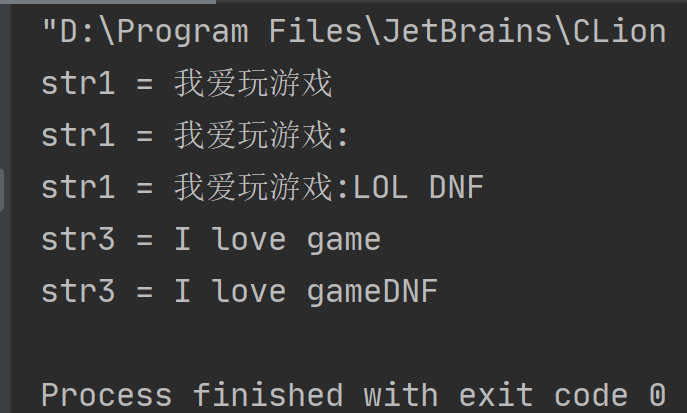
1.5 string查找和替换
功能描述:
1、查找:查找指定字符串是否存在;
2、替换:在指定位置替换字符串。
函数原型:
- int find(const string& str, int pos = 0) const; //查找str第一次出现位置,从pos开始查找
- int find(const char* s, int pos = 0) const; //查找s第一次出现位置,从pos开始查找
- int find(const char* s, int pos, int n) const; //从pos位置查找s的前n个字符第一次位置
- int find(const char c, int pos = 0) const; //查找字符c第一次出现位置
- int rfind(const string& str, int pos = npos) const; //查找str最后一次位置,从pos开始查找
- int rfind(const char* s, int pos = npos) const; //查找s最后一次出现位置,从pos开始查找
- int rfind(const char* s, int pos, int n) const; //从pos查找s的前n个字符最后一次位置
- int rfind(const char c, int pos = 0) const; //查找字符c最后一次出现位置
- string& replace(int pos, int n, const string& str); //替换从pos开始n个字符为字符串str
- string& replace(int pos, int n,const char* s); //替换从pos开始的n个字符为字符串s
示例:
#include <iostream>
using namespace std;
#include <string>
//查找和替换
void test01()
{
//1、查找
// find() 从左往右查找
string str1 = "abcdefgde";//其中a是0号位
// int pos = str1.find("a");//pos = 0
int pos = str1.find("de");
if (pos == -1)
{
cout << "未找到" << endl;
}
else
{
cout << "pos = " << pos << endl;
}
// rfind() 从右往左查找
pos = str1.rfind("de");
cout << "pos = " << pos << endl;
}
void test02()
{
//2、替换
string str1 = "abcdefgde";
str1.replace(1, 3, "1111");//从1号位置起3个字符,替换为“1111”
cout << "str1 = " << str1 << endl;
}
int main()
{
test01();
test02();
return 0;
}
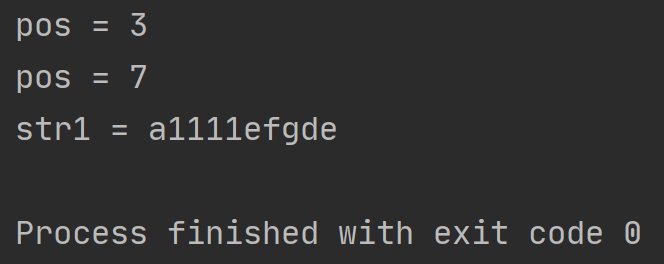
1.6 string字符串比较
功能描述:
字符串之间的比较。
比较方式:
字符串之间的ASCLL码比较。
= 返回 0;
> 返回 1;
< 返回-1。
函数原型:
- int compare(const string &s) const; //与字符串s比较
- int compare(const char *s) const; //与字符串s比较
示例:
#include <iostream>
using namespace std;
#include <string>
//字符串比较
void test01()
{
string str1 = "xello";
string str2 = "hello";
//关键:使用compare比较两个字符串的ASCLL码
if (str1.compare(str2) == 0) {
cout << "str1 等于 str2" << endl;
}
else if (str1.compare(str2) > 0)
{
cout << "str1 大于 str2" << endl;
}
else
{
cout << "str1 小于 str2" << endl;
}
}
int main()
{
test01();
return 0;
}
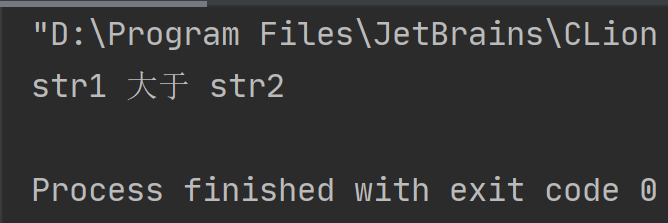
1.7 string字符串存取
string中单个字符串存取方式有两种:
- char& operator[](int n); //通过[]方式取字符
- char& at(int n); //通过at方法获取字符
示例:
#include <iostream>
using namespace std;
#include <string>
//字符串存取
void test01()
{
string str = "hello";
for (int i = 0; i < str.size(); i++)
{
cout << str[i] << " ";//关键1:通过[]访问单个字符
}
cout << endl;
for (int i = 0; i < str.size(); i++)
{
cout << str.at(i) << " ";//关键2:通过at方式访问单个字符
}
cout << endl;
//修改单个字符
str[0] = 'x';
cout << str << endl;//xello
str.at(1) = 'x';
cout << str << endl;//xxllo
}
int main()
{
test01();
return 0;
}
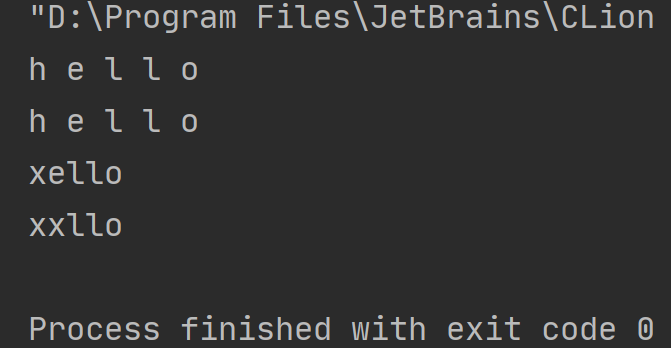
1.8 string插入和删除
功能描述:
对string字符串进行插入和删除字符操作
函数原型:
- string& insert(int pos, const char* s);//插入字符串
- string& insert(int pos, const string& str); //插入字符串
- string& insert(int pos, int n, char c);//在指定位置插入n个字符c
- string& erase(int pos, int n = npos); //删除从Pos开始的n个字符
示例:
#include <iostream>
using namespace std;
#include <string>
//字符串 插入和删除
void test01()
{
string str = "hello";
// 1、插入 关键1:insert();
str.insert(1, "111");//从第一个位置起,插入“111”
cout << str << endl;//h111ello
// 2、删除 关键2:erase();
str.erase(1, 3); //从1号位置开始删除3个字符
cout << str << endl;//hello
}
int main()
{
test01();
return 0;
}
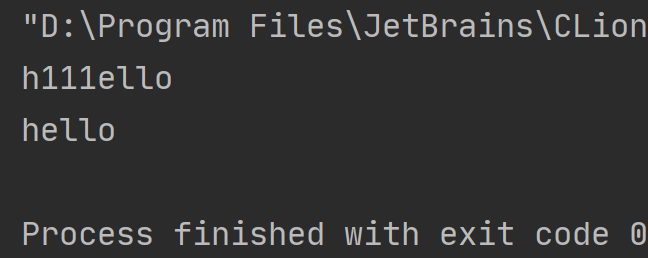
1.9 string子串
功能描述:
从字符串中获取想要的子串。
函数原型:
- string substr(int pos = 0, int n = npos) const;//返回由pos开始的n个字符组成的字符串
示例:
#include <iostream>
using namespace std;
#include <string>
//string求子串
void test01()
{
// 关键1:substr()
string str = "abcdefg";
string subStr = str.substr(1, 3);//从位置1开始截取3个字符
cout << "subStr = " << subStr << endl;//subStr = bcd
}
void test02()
{
// 例子:从邮箱地址中获取用户名信息
string email = "hello@sina.com";
int pos = email.find("@");
cout<<"@的位置:"<<pos<<endl;//@的位置:5
string username = email.substr(0, pos);
cout << "username: " << username << endl;//username: hello
}
int main()
{
test01();
test02();
return 0;
}

二、vector容器
2.1 vector的基本概念
功能:
vector数据结构和数组非常相似,也称为单端数组。
vector与普通数组区别:
不同之处在于数组是静态空间,而vector可以动态扩展。
动态扩展:
1、并不是在原空间之后续接新空间,而是寻找更大的内存空间,然后将元数据拷贝新空间,释放原空间。
2、vector容器的迭代器是支持随机访问的迭代器。
2.2 vector构造函数
功能描述:
创建vector容器。
函数原型:
- vector v; //采用模板实现类实现,默认构造函数
- vector(v.begin(), v.end()); //将v[begin(), end())区间中的元素拷贝给本身。
- vector(n, elem); //构造函数将n个elem拷贝给本身。
- vector(const vector &vec);//拷贝构造函数。
示例:
#include <iostream>
using namespace std;
#include <vector>
void printVector(vector<int>& v)
{
for (vector<int>::iterator it = v.begin(); it != v.end(); it++)
{
cout << *it << " ";
}
cout << endl;
}
void test01()
{
vector<int> v1; //无参构造
for (int i = 0; i < 10; i++)
{
v1.push_back(i);
}
printVector(v1);
//通过区间方式进行构造
vector<int> v2(v1.begin(), v1.end());
printVector(v2);
//通过n个elem方式构造
vector<int> v3(10, 100);
printVector(v3);
//拷贝构造
vector<int> v4(v3);
printVector(v4);
}
int main()
{
test01();
return 0;
}

2.3 vector赋值操作
功能描述:
给vector容器进行赋值。
函数原型:
- vector& operator=(const vector &vec);//重载等号操作符
- assign(beg, end); //将[beg, end)区间中的数据拷贝赋值给本身。
- assign(n, elem); //将n个elem拷贝赋值给本身。
示例:
#include <iostream>
using namespace std;
#include <vector>
void printVector(vector<int>& v)
{
for (vector<int>::iterator it = v.begin(); it != v.end(); it++)
{
cout << *it << " ";
}
cout << endl;
}
//赋值操作
void test01()
{
vector<int> v1; //无参构造
for (int i = 0; i < 10; i++)
{
v1.push_back(i);
}
printVector(v1);
vector<int>v2;
v2 = v1;//关键1:重载等号操作符
printVector(v2);
vector<int>v3;
v3.assign(v1.begin(), v1.end());//关键2:利用assign(beg,end)将[beg, end)区间中的数据拷贝赋值给本身。
printVector(v3);
vector<int>v4;
v4.assign(10, 100); //关键3:利用assign(n, elem)将n个elem拷贝赋值给本身。
printVector(v4);
}
int main()
{
test01();
return 0;
}
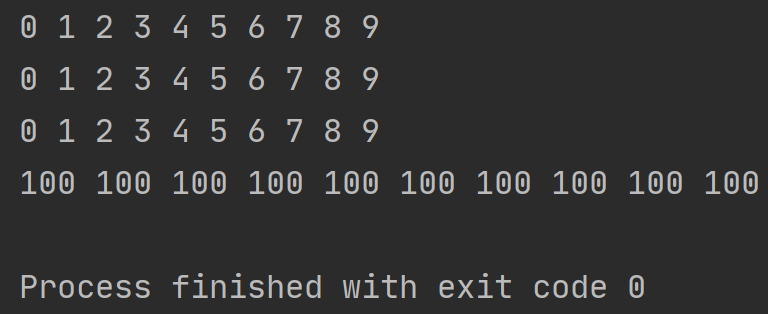
2.4 vector容量和大小
功能描述:
对vector容器的容量和大小操作。
函数原型:
- empty(); //判断容器是否为空
- capacity(); //容器的容量
- size(); //返回容器中元素的个数
- resize(int num); //重新指定容器的长度为num,若容器变长,则以默认值填充新位置。
//如果容器变短,则末尾超出容器长度的元素被删除。 - resize(int num, elem); //重新指定容器的长度为num,若容器变长,则以elem值填充新位置。
//如果容器变短,则末尾超出容器长度的元素被删除
示例:
#include <iostream>
using namespace std;
#include <vector>
void printVector(vector<int>& v)
{
for (vector<int>::iterator it = v.begin(); it != v.end(); it++)
{
cout << *it << " ";
}
cout << endl;
}
// vector容量和大小
void test01()
{
vector<int> v1;
for (int i = 0; i < 10; i++)
{
v1.push_back(i);
}
printVector(v1);
// 知识点1:利用empty()判断容器是否为空
if (v1.empty())
{
cout << "v1为空" << endl;
}
else
{
cout << "v1不为空" << endl;
cout << "v1的容量 = " << v1.capacity() << endl;//知识点2:利用capacity()容器的容量
cout << "v1的大小 = " << v1.size() << endl;//知识点3:size()返回容器中元素的个数
}
//知识点4:resize(int num, elem); 重新指定大小 ,若指定的更大,默认用0填充新位置,可以利用重载版本elem替换默认填充
v1.resize(15,10);
printVector(v1);
//知识点5:resize(int num); 重新指定大小 ,若指定的更小,超出部分元素被删除
v1.resize(5);
printVector(v1);
}
int main()
{
test01();
return 0;
}
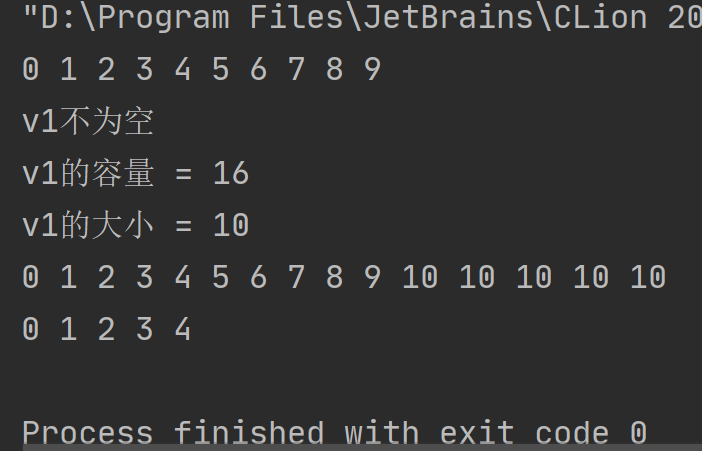
2.5 vector插入和删除
功能描述:
对vector容器进行插入、删除操作。
函数原型:
- push_back(ele); //尾部插入元素ele
- pop_back(); //删除最后一个元素
- insert(const_iterator pos, ele); //迭代器指向位置pos插入元素ele
- insert(const_iterator pos, int count,ele); //迭代器指向位置pos插入count个元素ele
- erase(const_iterator pos); //删除迭代器指向的元素
- erase(const_iterator start, const_iterator end); //删除迭代器从start到end之间的元素
- clear(); //删除容器中所有元素
示例:
#include <iostream>
using namespace std;
#include <vector>
void printVector(vector<int>& v)
{
for (vector<int>::iterator it = v.begin(); it != v.end(); it++)
{
cout << *it << " ";
}
cout << endl;
}
// vector插入和删除
void test01()
{
vector<int> v1;
//知识点1:push_back(ele)尾部插入元素ele
v1.push_back(10);
v1.push_back(20);
v1.push_back(30);
v1.push_back(40);
v1.push_back(50);
printVector(v1);
//知识点2:pop_back()尾删
v1.pop_back();
printVector(v1);
//知识点3:insert(const_iterator pos, ele)迭代器指向位置pos插入元素ele
v1.insert(v1.begin(), 100);
printVector(v1);
// 知识点4:insert(const_iterator pos, int count,ele)迭代器指向位置pos插入count个元素ele
v1.insert(v1.begin(), 2, 1000);
printVector(v1);
//知识点5:erase(const_iterator pos)删除迭代器指向的元素
v1.erase(v1.begin());
printVector(v1);
//知识点6:erase(const_iterator start, const_iterator end)删除迭代器从start到end之间的元素
v1.erase(v1.begin(), v1.end());
// 知识点7:clear()删除容器中所有元素
v1.clear();
printVector(v1);
}
int main()
{
test01();
return 0;
}
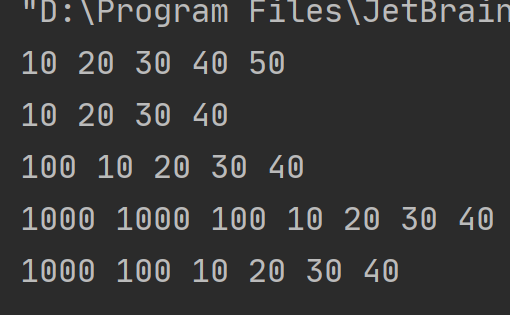
2.6 vector数据存取
功能描述:
对vector容器的数据进行存取操作。
函数原型:
- at(int idx); //返回索引idx所指的数据
- operator[]; //返回索引idx所指的数据
- front(); //返回容器中第一个数据元素
- back(); //返回容器中最后一个数据元素
示例:
#include <iostream>
using namespace std;
#include <vector>
//vector数据存取
void test01()
{
vector<int>v1;
for (int i = 0; i < 10; i++)
{
v1.push_back(i);
}
for (int i = 0; i < v1.size(); i++)
{
cout << v1[i] << " ";//知识点1:operator[]返回索引idx所指的数据
}
cout << endl;
for (int i = 0; i < v1.size(); i++)
{
cout << v1.at(i) << " ";//知识点2:at(int idx)返回索引idx所指的数据
}
cout << endl;
cout << "v1的第一个元素为: " << v1.front() << endl;//知识点3:front()返回容器中第一个数据元素
cout << "v1的最后一个元素为: " << v1.back() << endl;//知识点4:back()返回容器中最后一个数据元素
}
int main()
{
test01();
return 0;
}
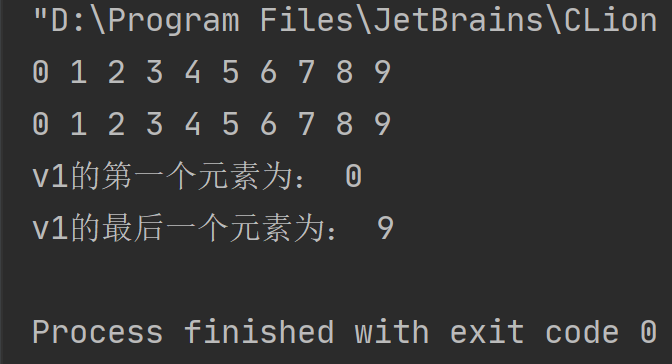
2.7 互换容器
功能描述:
实现两个容器内的数据进行互换。
函数原型:
- swap(vec); // 将vec与本身的元素互换
示例:
#include <iostream>
using namespace std;
#include <vector>
void printVector(vector<int>& v)
{
for (vector<int>::iterator it = v.begin(); it != v.end(); it++)
{
cout << *it << " ";
}
cout << endl;
}
//vector互换容器
void test01()
{
vector<int>v1;
for (int i = 0; i < 10; i++)
{
v1.push_back(i);
}
printVector(v1);//0 1 2 3 4 5 6 7 8 9
vector<int>v2;
for (int i = 10; i > 0; i--)
{
v2.push_back(i);
}
printVector(v2);//10 9 8 7 6 5 4 3 2 1
//互换容器
cout << "互换后" << endl;
v1.swap(v2);//知识点1:swap(vec)将vec与本身的元素互换
printVector(v1);//10 9 8 7 6 5 4 3 2 1
printVector(v2);//0 1 2 3 4 5 6 7 8 9
}
void test02()
{
vector<int> v;
for (int i = 0; i < 100000; i++)
{
v.push_back(i);
}
cout << "v的容量为:" << v.capacity() << endl;//131072
cout << "v的大小为:" << v.size() << endl;//100000
v.resize(3);//重新指定容器长度
cout << "v的容量为:" << v.capacity() << endl;//131072
cout << "v的大小为:" << v.size() << endl;//3
//实际用途:收缩内存
vector<int>(v).swap(v); //匿名对象
cout << "v的容量为:" << v.capacity() << endl;//3
cout << "v的大小为:" << v.size() << endl;//3
}
int main()
{
test01();
test02();
return 0;
}
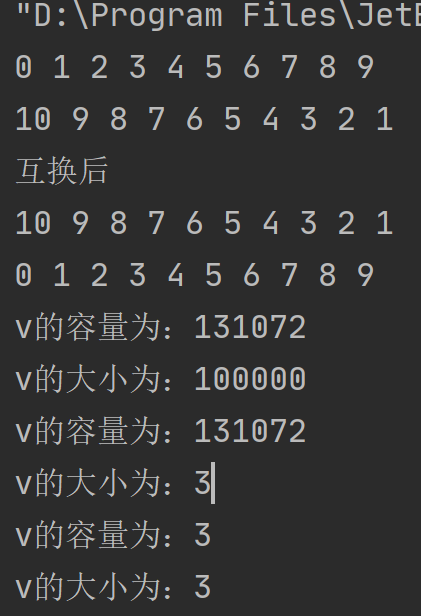
2.8 vector预留空间
功能描述:
减少vector在动态扩展容量时的扩展次数。
函数原型:
- reserve(int len); //容器预留len个元素长度,预留位置不初始化,元素不可访问。
示例:
#include <iostream>
using namespace std;
#include <vector>
//vector预留空间
void test01()
{
vector<int> v;
//知识点1:reserve(int len)容器预留len个元素长度,预留位置不初始化,元素不可访问。
v.reserve(100000);
int num = 0;
int* p = NULL;
for (int i = 0; i < 100000; i++)
{
v.push_back(i);
if (p != &v[0])
{
p = &v[0];
num++;
}
}
cout << "num:" << num << endl;
}
int main()
{
test01();
return 0;
}

三、deque容器
3.1 deque容器的基本概率
功能:
双端数组,可以对头端进行插入删除操作。
deque和vector区别:
1、vector对于头部的插入删除效率低,数据量大,效率越低;
2、deque相对而言,对头部的插入删除速度会比vector块;
3、vector访问元素时的速度会比deque快,这和两者内部实现相关。
deque内部工作原理:
1、deque内部有个中控器,维护每段缓冲区中的容器,缓冲区中存放真实数据。
2、中控器维护的是每个缓冲区的地址,使得使用deque时像一片连续的内存空间。
3、deque容器的迭代器也是支持随机访问的。
3.2 deque构造函数
功能描述:
deque容器构造。
函数原型:
- deque deqT; //默认构造形式
- deque(beg, end);//构造函数将[beg, end)区间中的元素拷贝给本身。
- deque(n, elem);//构造函数将n个elem拷贝给本身。
- deque(const deque &deq); //拷贝构造函数
示例:
#include <iostream>
using namespace std;
#include <deque>
void printDeque(const deque<int>& d)
{
for (deque<int>::const_iterator it = d.begin(); it != d.end(); it++)
{
cout << *it << " ";
}
cout << endl;
}
//deque构造
void test01() {
// 知识点1:deque<T> deqT; //默认构造形式
deque<int> d1;
for (int i = 0; i < 10; i++)
{
d1.push_back(i);
}
printDeque(d1);//0 1 2 3 4 5 6 7 8 9
// 知识点2:deque(beg, end); //构造函数将[beg, end)区间中的元素拷贝给本身
deque<int> d2(d1.begin(),d1.end());
printDeque(d2);//0 1 2 3 4 5 6 7 8 9
// 知识点3:deque(n, elem); //构造函数将n个elem拷贝给本身
deque<int>d3(10,100);
printDeque(d3);//100 100 100 100 100 100 100 100 100 100
// 知识点4:deque(const deque &deq); //拷贝构造函数
deque<int>d4 = d3;
printDeque(d4);//100 100 100 100 100 100 100 100 100 100
}
int main()
{
test01();
return 0;
}
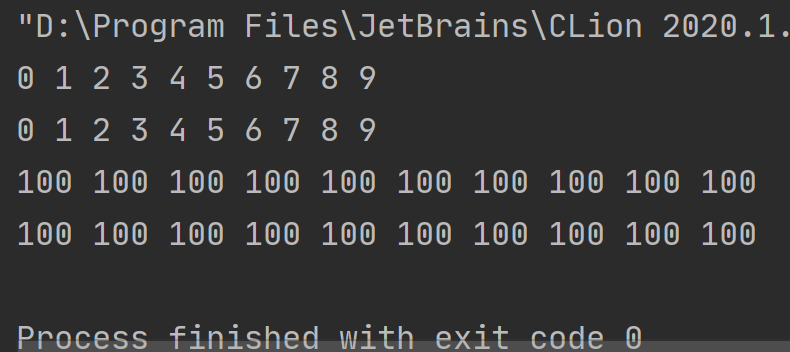
3.3 deque赋值操作
功能描述:
给deque容器进行赋值。
函数原型:
- deque& operator=(const deque &deq); //重载等号操作符
- assign(beg, end);//将[beg, end)区间中的数据拷贝赋值给本身。
- assign(n, elem); //将n个elem拷贝赋值给本身。
示例:
#include <iostream>
using namespace std;
#include <deque>
void printDeque(const deque<int>& d)
{
for (deque<int>::const_iterator it = d.begin(); it != d.end(); it++)
{
cout << *it << " ";
}
cout << endl;
}
//deque赋值操作
void test01()
{
deque<int> d1;
for (int i = 0; i < 10; i++)
{
d1.push_back(i);
}
printDeque(d1);
// 知识点1: deque& operator=(const deque &deq); //重载等号操作符
deque<int>d2;
d2 = d1;
printDeque(d2);
// 知识点2:assign(beg, end); //将[beg, end)区间中的数据拷贝赋值给本身。
deque<int>d3;
d3.assign(d1.begin(), d1.end());
printDeque(d3);
// 知识点3: assign(n, elem); //将n个elem拷贝赋值给本身。
deque<int>d4;
d4.assign(10, 100);
printDeque(d4);
}
int main()
{
test01();
return 0;
}
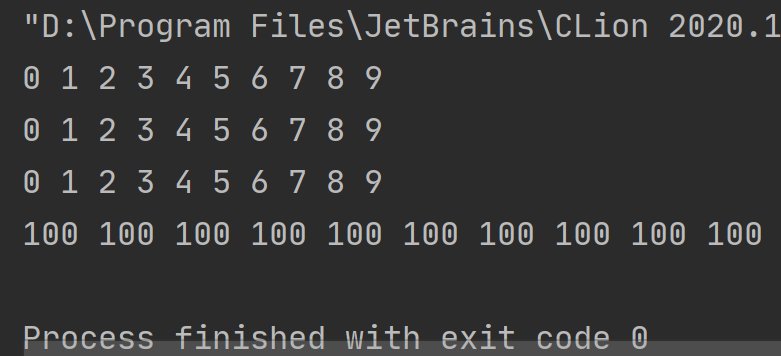
3.4 deque大小操作
功能描述:
对deque容器的大小进行操作。
函数原型:
- deque.empty(); //判断容器是否为空
- deque.size(); //返回容器中元素的个数
- deque.resize(num);//重新指定容器的长度为num,若容器变长,则以默认值填充新位置。
//如果容器变短,则末尾超出容器长度的元素被删除。 - deque.resize(num, elem); //重新指定容器的长度为num,若容器变长,则以默认值填充新位置。
//如果容器变短,则末尾超出容器长度的元素被删除。
#include <iostream>
using namespace std;
#include <deque>
void printDeque(const deque<int>& d)
{
for (deque<int>::const_iterator it = d.begin(); it != d.end(); it++)
{
cout << *it << " ";
}
cout << endl;
}
//deque大小操作
void test01()
{
deque<int> d1;
for (int i = 0; i < 10; i++)
{
d1.push_back(i);
}
printDeque(d1);
// 1、 deque.empty(); //判断容器是否为空
if (d1.empty()) {
cout << "d1为空!" << endl;
}
else {
cout << "d1不为空!" << endl;
// 2、deque.size(); //返回容器中元素的个数
cout << "d1的大小为:" << d1.size() << endl;
}
// 3、 deque.resize(num, elem);//重新指定大小
d1.resize(15, 1);
printDeque(d1);
// 4、 deque.resize(num);//重新指定大小
d1.resize(5);
printDeque(d1);
}
int main()
{
test01();
return 0;
}
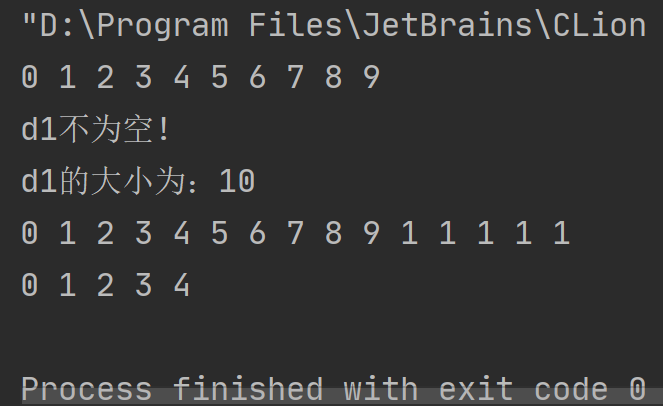
3.5 deque插入和删除
功能描述:
- 向deque容器中插入和删除数据。
函数原型:
1、两端插入操作:
- push_back(elem); //在容器尾部添加一个数据
- push_front(elem);//在容器头部插入一个数据
- pop_back();//删除容器最后一个数据
- pop_front(); //删除容器第一个数据
2、指定位置操作:
- insert(pos,elem); //在pos位置插入一个elem元素的拷贝,返回新数据的位置。
- insert(pos,n,elem); //在pos位置插入n个elem数据,无返回值。
- insert(pos,beg,end); //在pos位置插入[beg,end)区间的数据,无返回值。
- clear();//清空容器的所有数据
- erase(beg,end); //删除[beg,end)区间的数据,返回下一个数据的位置。
- erase(pos); //删除pos位置的数据,返回下一个数据的位置。
示例:
#include <iostream>
using namespace std;
#include <deque>
//deque 插入和删除
void printDeque(const deque<int>& d)
{
for (deque<int>::const_iterator it = d.begin(); it != d.end(); it++)
{
cout << *it << " ";
}
cout << endl;
}
//1、两端操作
void test01()
{
deque<int> d;
// 1-1、push_back(elem); //在容器尾部添加一个数据
d.push_back(10);
d.push_back(20);
// 1-2、push_front(elem); //在容器头部插入一个数据
d.push_front(100);
d.push_front(200);
printDeque(d);//200 100 10 20
// 1-3、pop_back(); //删除容器最后一个数据
d.pop_back();
// 1-4、pop_front(); //删除容器第一个数据
d.pop_front();
printDeque(d);//100 10
}
//2、插入
void test02()
{
deque<int> d;
d.push_back(10);
d.push_back(20);
d.push_front(100);
d.push_front(200);
printDeque(d);//200 100 10 20
// 2-1 insert(pos,elem); //在pos位置插入一个elem元素的拷贝,返回新数据的位置。
d.insert(d.begin(), 1000);
printDeque(d);//1000 200 100 10 20
// 2-2 insert(pos,n,elem); //在pos位置插入n个elem数据,无返回值。
d.insert(d.begin(), 2,10000);
printDeque(d);//10000 10000 1000 200 100 10 20
deque<int>d2;
d2.push_back(1);
d2.push_back(2);
d2.push_back(3);
// 2-3 insert(pos,beg,end); //在pos位置插入[beg,end)区间的数据,无返回值。
d.insert(d.begin(), d2.begin(), d2.end());
printDeque(d);//1 2 3 10000 10000 1000 200 100 10 20
}
//删除
void test03()
{
deque<int> d;
d.push_back(10);
d.push_back(20);
d.push_front(100);
d.push_front(200);
printDeque(d);//200 100 10 20
// 3-1 erase(pos); //删除pos位置的数据,返回下一个数据的位置。
d.erase(d.begin());
printDeque(d);//100 10 20
// 3-2 erase(beg,end); //删除[beg,end)区间的数据,返回下一个数据的位置。
d.erase(d.begin(), d.end());
// 3-3 clear(); //清空容器的所有数据
d.clear();
printDeque(d);
}
int main()
{
test01();
test02();
test03();
return 0;
}

3.6 deque数据存取
功能描述:
对deque中的数据的存取操作。
函数原型:
- at(int idx); //返回索引idx所指的数据
- operator[]; //返回索引idx所指的数据
- front();//返回容器中第一个数据元素
- back(); //返回容器中最后一个数据元素
示例:
#include <iostream>
using namespace std;
#include <deque>
void printDeque(const deque<int>& d)
{
for (deque<int>::const_iterator it = d.begin(); it != d.end(); it++)
{
cout << *it << " ";
}
cout << endl;
}
//deque 数据存取数据存取
void test01()
{
deque<int> d;
d.push_back(10);
d.push_back(20);
d.push_front(30);
d.push_front(40);
for (int i = 0; i < d.size(); i++)
{
// 1、 operator[]; //返回索引idx所指的数据
cout << d[i] << " ";
}
cout << endl;
for (int i = 0; i < d.size(); i++)
{
// 2、 at(int idx); //返回索引idx所指的数据
cout << d.at(i) << " ";
}
cout << endl;
// 3、front(); //返回容器中第一个数据元素
cout << "第一个元素为:" << d.front() << endl;//第一个元素为:40
// 4、back(); //返回容器中最后一个数据元素
cout << "最后一个元素为:" << d.back() << endl;//最后一个元素为:20
}
int main()
{
test01();
return 0;
}
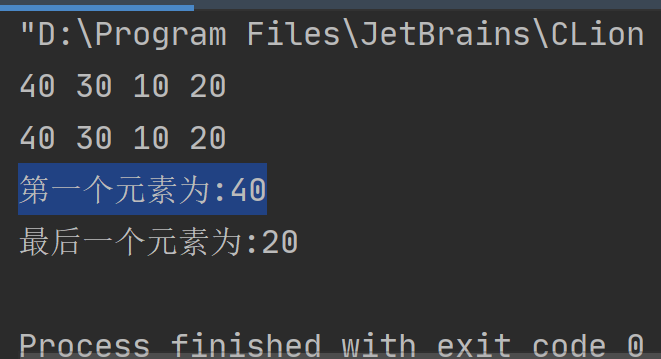
3.7 deque排序
功能描述:
利用算法对deque容器进行排序。
函数原型:
- sort(iterator beg, iterator end); //对beg和end区间内元素进行排序
示例:
#include <iostream>
using namespace std;
#include <deque>
#include <algorithm>
//deque 排序
void printDeque(const deque<int>& d)
{
for (deque<int>::const_iterator it = d.begin(); it != d.end(); it++)
{
cout << *it << " ";
}
cout << endl;
}
void test01()
{
deque<int> d;
d.push_back(10);
d.push_back(20);
d.push_front(300);
d.push_front(400);
printDeque(d);//400 300 10 20
// 1、 sort(iterator beg, iterator end) //对beg和end区间内元素进行排序
sort(d.begin(), d.end());
printDeque(d);//10 20 300 400
}
int main()
{
test01();
return 0;
}

四、stack容器
4.1 stack的基本概念
基本概念:
stack是一种先进后出的数据结构,它只有一个出口
注意事项:
1、栈中只有顶端的元素才可以被外界使用,因此栈不允许有遍历行为。
2、栈中进入数据称为——入栈push
3、栈中弹出数据称为——出栈pop
4.2 stack 常用接口
功能描述:
栈容器常用的对外接口。
构造函数:
- stack stk;//stack采用模板类实现, stack对象的默认构造形式
- stack(const stack &stk);//拷贝构造函数
赋值操作:
- stack& operator=(const stack &stk); //重载等号操作符
数据存取:
- push(elem);//向栈顶添加元素
- pop();//从栈顶移除第一个元素
- top(); //返回栈顶元素
大小操作:
- empty(); //判断堆栈是否为空
- size(); //返回栈的大小
示例:
#include <iostream>
using namespace std;
#include <stack>
//栈容器常用接口
void test01()
{
//创建栈容器 符合先进后出
stack<int> s;
// 1、push(elem); //向栈顶添加元素
s.push(10);
s.push(20);
s.push(30);
s.push(40);
while (!s.empty())
{
// 2、 top(); //返回栈顶元素
cout << "栈顶元素为: " << s.top() << endl;
// 3、 pop(); //从栈顶移除第一个元素
s.pop();
}
cout << "栈的大小为:" << s.size() << endl;
}
int main()
{
test01();
return 0;
}

五、queue容器
5.1 queue基本概念
基本概念:
queue是一种先进先出的数据结构,它有两个出口,队列中允许从一端新增元素,从另一端移除元素。
注意事项:
1、队列中只有对头和队尾才可以被外界使用,因此不允许队列有遍历行为;
2、队列中进数据称为——入队push;
3、队列中出数据称为——出队pop。
5.2 queue常用接口
功能描述:
栈容器常用的对外接口。
构造函数:
- queue que; //queue采用模板类实现,queue对象的默认构造形式
- queue(const queue &que); //拷贝构造函数
赋值操作:
- queue& operator=(const queue &que); //重载等号操作符
数据存取:
- push(elem);//往队尾添加元素
- pop(); //从队头移除第一个元素
- back(); //返回最后一个元素
- front();//返回第一个元素
大小操作:
- empty(); //判断堆栈是否为空
- size(); //返回栈的大小
示例:
#include <iostream>
using namespace std;
#include <queue>
#include <string>
class Person
{
public:
Person(string name, int age)
{
this->m_Name = name;
this->m_Age = age;
}
string m_Name;
int m_Age;
};
void test01()
{
//创建队列
queue<Person> q;
//准备数据
Person p1("唐僧", 30);
Person p2("孙悟空", 1000);
Person p3("猪八戒", 900);
Person p4("沙僧", 800);
// push(elem); //往队尾添加元素
q.push(p1);
q.push(p2);
q.push(p3);
q.push(p4);
while (!q.empty())
{
// front(); //返回第一个元素
cout << "队头元素-- 姓名: " << q.front().m_Name
<< " 年龄: "<< q.front().m_Age << endl;
// back(); //返回最后一个元素
cout << "队尾元素-- 姓名: " << q.back().m_Name
<< " 年龄: " << q.back().m_Age << endl;
cout << endl;
// pop(); //从队头移除第一个元素
q.pop();
}
cout << "队列大小为:" << q.size() << endl;
}
int main()
{
test01();
return 0;
}

六、list容器
6.1 list基本概念
功能:
将数据进行链式存储。
注意事项:
1、链表(list)是一种物理存储单元上非连续的存储结构,数据元素的逻辑顺序是通过链表中的指针链接实现的。
2、链表的组成:链表由一系列节点组成。
3、节点的组成:一个是存储数据元素的数据域,另一个是存储下一个节点地址的指针域。STL中的链表是一个双向循环链表。
4、由于链表的存储方式并不是连续的内存空间,因此链表list中的迭代器只支持前移和后移,属于双向迭代器。
5、list的优点:
(1)采用动态存储分配,不会再次内存浪费和溢出。
(2)链表执行插入和删除操作十分方便,修改指针即可,不需要移动大量元素。
6、list的缺点:
链表灵活,但是空间(指针域)和时间(遍历)额外耗费大。
7、list有一个重要的性质,插入操作和删除操作都不会造成原有list迭代器的实效,这在vector是不成立的。
8、总结:STL中list和vector是两个最常被使用的容器,各有优缺点。
6.2 list构造函数
功能描述:
创建list容器。
函数原型:
- list lst; //list采用采用模板类实现,对象的默认构造形式:
- list(beg,end); //构造函数将[beg, end)区间中的元素拷贝给本身。
- list(n,elem); //构造函数将n个elem拷贝给本身。
- list(const list &lst); //拷贝构造函数。
示例:
#include <iostream>
using namespace std;
#include <list>
void printList(const list<int>& L)
{
for (list<int>::const_iterator it = L.begin(); it != L.end(); it++)
{
cout << *it << " ";
}
cout << endl;
}
void test01()
{
// 1、list<T> lst; //list采用采用模板类实现,对象的默认构造形式:
list<int>L1;
//添加数据
L1.push_back(10);
L1.push_back(20);
L1.push_back(30);
L1.push_back(40);
printList(L1);//10 20 30 40
// 2、 list(beg,end); //构造函数将[beg, end)区间中的元素拷贝给本身。
list<int>L2(L1.begin(),L1.end());
printList(L2);//10 20 30 40
// 3、 list(n,elem); //构造函数将n个elem拷贝给本身。
list<int>L3(L2);
printList(L3);//10 20 30 40
// 4、 list(const list &lst); //拷贝构造函数。
list<int>L4(10, 1000);
printList(L4);//1000 1000 1000 1000 1000 1000 1000 1000 1000 1000
}
int main()
{
test01();
return 0;
}

6.3 list赋值和交换
功能描述:
给list容器进行赋值,以及交换list容器。
函数原型:
- assign(beg, end); //将[beg, end)区间中的数据拷贝赋值给本身。
- assign(n, elem); //将n个elem拷贝赋值给本身。
- list& operator=(const list &lst); //重载等号操作符
- swap(lst); //将lst与本身的元素互换。
示例:
#include <iostream>
using namespace std;
#include <list>
void printList(const list<int>& L)
{
for (list<int>::const_iterator it = L.begin(); it != L.end(); it++)
{
cout << *it << " ";
}
cout << endl;
}
//赋值和交换
void test01()
{
list<int>L1;
L1.push_back(10);
L1.push_back(20);
L1.push_back(30);
L1.push_back(40);
printList(L1);
//赋值
list<int>L2;
// 1、 operator=赋值
L2 = L1;
printList(L2);
list<int>L3;
// 2、 assign(beg, end); //将[beg, end)区间中的数据拷贝赋值给本身。
L3.assign(L2.begin(), L2.end());
printList(L3);
list<int>L4;
// 3、 assign(n, elem); //将n个elem拷贝赋值给本身
L4.assign(10, 100);
printList(L4);
}
//交换
void test02()
{
list<int>L1;
L1.push_back(10);
L1.push_back(20);
L1.push_back(30);
L1.push_back(40);
list<int>L2;
L2.assign(10, 100);
cout << "交换前: " << endl;
printList(L1);
printList(L2);
cout << endl;
// 4、 swap(lst); //将lst与本身的元素互换。
L1.swap(L2);
cout << "交换后: " << endl;
printList(L1);
printList(L2);
}
int main()
{
test01();
test02();
return 0;
}
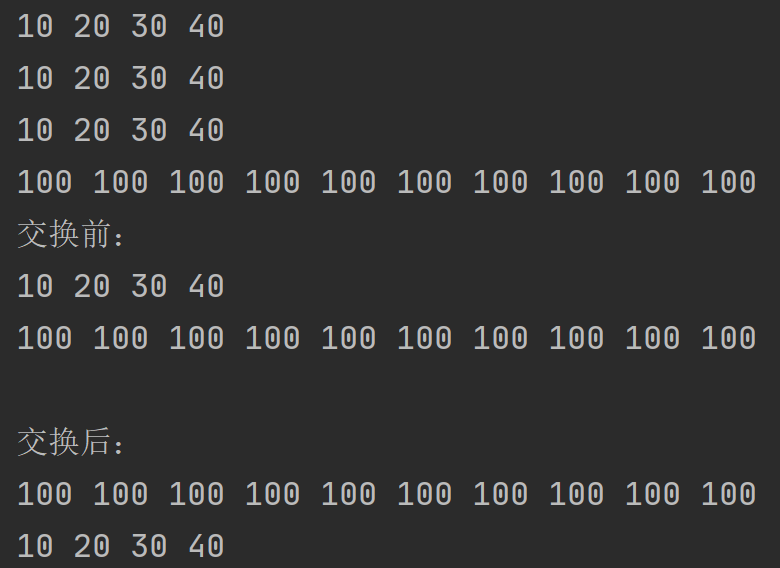
6.4 list大小操作
功能描述:
对list容器的大小进行操作。
函数原型:
- size(); //返回容器中元素的个数
- empty(); //判断容器是否为空
- resize(num); //重新指定容器的长度为num,若容器变长,则以默认值填充新位置。
//如果容器变短,则末尾超出容器长度的元素被删除。 - resize(num, elem);//重新指定容器的长度为num,若容器变长,则以elem值填充新位置。
示例:
#include <iostream>
using namespace std;
#include <list>
void printList(const list<int>& L)
{
for (list<int>::const_iterator it = L.begin(); it != L.end(); it++)
{
cout << *it << " ";
}
cout << endl;
}
//大小操作
void test01()
{
list<int>L1;
L1.push_back(10);
L1.push_back(20);
L1.push_back(30);
L1.push_back(40);
// 1、 empty(); //判断容器是否为空
if (L1.empty())
{
cout << "L1为空" << endl;
}
else
{
cout << "L1不为空" << endl;
// 2、 size(); //返回容器中元素的个数
cout << "L1的大小为:" << L1.size() << endl;
}
// 3、 resize(num); //重新指定容器的长度为num,若容器变长,则以默认值填充新位置。
L1.resize(10);
printList(L1);
// 4、 resize(num, elem); //重新指定容器的长度为num,若容器变长,则以elem值填充新位置。
L1.resize(15,5);
printList(L1);
}
int main()
{
test01();
return 0;
}

6.5 list 插入和删除
功能描述:
对list容器进行数据的插入和删除。
函数原型:
- push_back(elem);//在容器尾部加入一个元素
- pop_back();//删除容器中最后一个元素
- push_front(elem);//在容器开头插入一个元素
- pop_front();//从容器开头移除第一个元素
- insert(pos,elem);//在pos位置插elem元素的拷贝,返回新数据的位置。
- insert(pos,n,elem);//在pos位置插入n个elem数据,无返回值。
- insert(pos,beg,end);//在pos位置插入[beg,end)区间的数据,无返回值。
- clear();//移除容器的所有数据
- erase(beg,end);//删除[beg,end)区间的数据,返回下一个数据的位置。
- erase(pos);//删除pos位置的数据,返回下一个数据的位置。
- remove(elem);//删除容器中所有与elem值匹配的元素。
示例:
#include <iostream>
using namespace std;
#include <list>
void printList(const list<int>& L)
{
for (list<int>::const_iterator it = L.begin(); it != L.end(); it++)
{
cout << *it << " ";
}
cout << endl;
}
//list 插入和删除
void test01()
{
list<int> L;
//1、尾插
L.push_back(10);
L.push_back(20);
L.push_back(30);
//2、头插
L.push_front(100);
L.push_front(200);
L.push_front(300);
printList(L);
//3、尾删
L.pop_back();
printList(L);
//4、头删
L.pop_front();
printList(L);
//5、插入
list<int>::iterator it = L.begin();
L.insert(++it, 1000);
printList(L);
//6、删除
it = L.begin();
L.erase(++it);
printList(L);
L.push_back(10000);
L.push_back(10000);
L.push_back(10000);
printList(L);
// 7、 remove(elem);//删除容器中所有与elem值匹配的元素。
L.remove(10000);
printList(L);
// 8、清空
L.clear();
printList(L);
}
int main()
{
test01();
return 0;
}
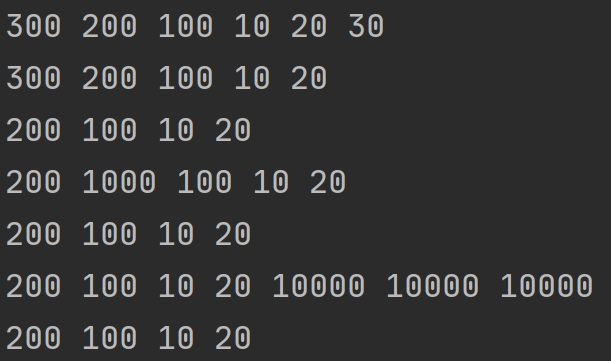
6.6 list数据存取
功能描述:
对list容器中的数据进行存取。
函数原型:
- front(); //返回第一个元素。
- back(); //返回最后一个元素。
示例:
#include <iostream>
using namespace std;
#include <list>
//数据存取
void test01()
{
list<int>L1;
L1.push_back(10);
L1.push_back(20);
L1.push_back(30);
L1.push_back(40);
//cout << L1.at(0) << endl;//错误 不支持at访问数据
//cout << L1[0] << endl; //错误 不支持[]方式访问数据
// 原因:list本质是链表,不是用连续线性空间存储数据
// 1、 front(); //返回第一个元素。
cout << "第一个元素为: " << L1.front() << endl;//第一个元素为: 10
// 2、 back(); //返回最后一个元素。
cout << "最后一个元素为: " << L1.back() << endl;//最后一个元素为: 40
//list容器的迭代器是双向迭代器,不支持随机访问
list<int>::iterator it = L1.begin();
//it = it + 1;//错误,不可以跳跃访问,即使是+1
}
int main()
{
test01();
return 0;
}

6.7 反转和排序
功能描述:
将容器中的元素反转,以及将容器中的数据进行排序。
函数原型:
- reverse();//反转链表
- sort();//链表排序
示例:
#include <iostream>
using namespace std;
#include <list>
void printList(const list<int>& L)
{
for (list<int>::const_iterator it = L.begin(); it != L.end(); it++)
{
cout << *it << " ";
}
cout << endl;
}
bool myCompare(int val1 , int val2)
{
return val1 > val2;
}
//反转和排序
void test01()
{
list<int> L;
L.push_back(20);
L.push_back(10);
L.push_back(50);
L.push_back(40);
L.push_back(30);
printList(L);//20 10 50 40 30
// 1、 reverse(); //反转链表
L.reverse();
printList(L);//30 40 50 10 20
// 2、 sort(); //链表排序
L.sort(); //默认的排序规则 从小到大
printList(L);//10 20 30 40 50
L.sort(myCompare); //指定规则,从大到小
printList(L);//50 40 30 20 10
}
int main()
{
test01();
return 0;
}

七、set/multiset容器
7.1 set的基本概念
简介:
所有元素都会在插入时自动排序。
本质:
set/multiset属于关联式容器,底层结构是用二叉树实现。
set/multiset区别:
set不允许容器中有重复元素;
multiset允许容器中有重复元素。
7.2 set构造和赋值
功能描述:
创建set容器以及赋值。
函数原型:
构造:
- set st; //默认构造函数:
- set(const set &st);//拷贝构造函数
赋值: - set& operator=(const set &st); //重载等号操作符
示例:
#include <iostream>
using namespace std;
#include <set>
void printSet(set<int> & s)
{
for (set<int>::iterator it = s.begin(); it != s.end(); it++)
{
cout << *it << " ";
}
cout << endl;
}
//set构造和赋值
void test01()
{
// 1、 set<T> st; //默认构造函数:
set<int> s1;
// 插入数据用insert
s1.insert(10);
s1.insert(30);
s1.insert(20);
s1.insert(40);
// set插入数据会自动排序
printSet(s1);//10 20 30 40
// 2、 set(const set &st); //拷贝构造函数
set<int>s2(s1);
printSet(s2);
// 3、 set& operator=(const set &st); //重载等号操作符
set<int>s3;
s3 = s2;
printSet(s3);
}
int main()
{
test01();
return 0;
}

7.3 set大小和交换
功能描述:
统计set容器大小以及交换set容器。
函数原型:
- size(); //返回容器中元素的数目
- empty(); //判断容器是否为空
- swap(st); //交换两个集合容器
示例:
#include <iostream>
using namespace std;
#include <set>
void printSet(set<int> & s)
{
for (set<int>::iterator it = s.begin(); it != s.end(); it++)
{
cout << *it << " ";
}
cout << endl;
}
/*set大小和交换*/
//大小
void test01()
{
set<int> s1;
s1.insert(10);
s1.insert(30);
s1.insert(20);
s1.insert(40);
// 1、 empty(); //判断容器是否为空
if (s1.empty())
{
cout << "s1为空" << endl;
}
else
{
cout << "s1不为空" << endl;
// 2、 size(); //返回容器中元素的数目
cout << "s1的大小为: " << s1.size() << endl;
}
}
//交换
void test02()
{
set<int> s1;
s1.insert(10);
s1.insert(30);
s1.insert(20);
s1.insert(40);
set<int> s2;
s2.insert(100);
s2.insert(300);
s2.insert(200);
s2.insert(400);
cout << "交换前" << endl;
printSet(s1);//10 20 30 40
printSet(s2);//100 200 300 400
cout << endl;
cout << "交换后" << endl;
// 3、 swap(st); //交换两个集合容器
s1.swap(s2);
printSet(s1);//100 200 300 400
printSet(s2);//10 20 30 40
}
int main()
{
test01();
test02();
return 0;
}

7.4 set插入和删除
功能描述:
set容器进行插入数据和删除数据。
函数原型:
- insert(elem);//在容器中插入元素。
- clear(); //清除所有元素
- erase(pos);//删除pos迭代器所指的元素,返回下一个元素的迭代器。
- erase(beg, end);//删除区间[beg,end)的所有元素 ,返回下一个元素的迭代器。
- erase(elem); //删除容器中值为elem的元素。
示例:
#include <iostream>
using namespace std;
#include <set>
void printSet(set<int> & s)
{
for (set<int>::iterator it = s.begin(); it != s.end(); it++)
{
cout << *it << " ";
}
cout << endl;
}
//set插入和删除
void test01()
{
set<int> s1;
// 1、 insert(elem); //在容器中插入元素。
s1.insert(10);
s1.insert(30);
s1.insert(20);
s1.insert(40);
printSet(s1);//10 20 30 40
// 2、 erase(pos); //删除pos迭代器所指的元素,返回下一个元素的迭代器。
s1.erase(s1.begin());
printSet(s1);//20 30 40
// 3、 erase(elem); //删除容器中值为elem的元素。
s1.erase(30);
printSet(s1);//20 40
// 4、 erase(beg, end); //删除区间[beg,end)的所有元素 ,返回下一个元素的迭代器。
//s1.erase(s1.begin(), s1.end());
// 5、 clear(); //清除所有元素
s1.clear();
printSet(s1);
}
int main()
{
test01();
return 0;
}

7.5 set查找和统计
功能描述:
对set容器进行查找数据以及统计数据。
函数原型:
- find(key); //查找key是否存在,若存在,返回该键的元素的迭代器;若不存在,返回set.end();
- count(key); //统计key的元素个数
示例:
#include <iostream>
using namespace std;
#include <set>
void printSet(set<int> & s)
{
for (set<int>::iterator it = s.begin(); it != s.end(); it++)
{
cout << *it << " ";
}
cout << endl;
}
//set查找和统计
void test01()
{
set<int> s1;
//插入
s1.insert(10);
s1.insert(30);
s1.insert(20);
s1.insert(40);
// 1、 find(key); //查找key是否存在,若存在,返回该键的元素的迭代器;若不存在,返回set.end();
set<int>::iterator pos = s1.find(30);
if (pos != s1.end())
{
cout << "找到了元素 : " << *pos << endl;
}
else
{
cout << "未找到元素" << endl;
}
// 2、 count(key); //统计key的元素个数
int num = s1.count(30);
cout << "num = " << num << endl;
}
int main()
{
test01();
return 0;
}

7.6 set和multiset区别
1、set不可以插入重复数据,而multiset可以。
2、set插入数据的同时会返回插入结果,表示插入成功。
3、multiset不会检测数据,因此可以插入重复数据。
示例:
#include <iostream>
using namespace std;
#include <set>
//set和multiset容器的区别
void test01()
{
set<int> s;
pair<set<int>::iterator, bool> ret = s.insert(10);
if (ret.second)
{
cout << "第一次插入成功!" << endl;
}
else
{
cout << "第一次插入失败!" << endl;
}
ret = s.insert(10);
if (ret.second) {
cout << "第二次插入成功!" << endl;
}
else {
cout << "第二次插入失败!" << endl;
}
//multiset
multiset<int> ms;
ms.insert(10);
ms.insert(10);
for (multiset<int>::iterator it = ms.begin(); it != ms.end(); it++)
{
cout << *it << " ";
}
cout << endl;
}
int main()
{
test01();
return 0;
}

7.7 pair对组创建
功能描述:
成对出现的数据。利用对组可以返回两个数据。
函数原型:
- pair<type, type> p ( value1, value2 );
- pair<type, type> p = make_pair( value1, value2 );
示例:
#include <iostream>
using namespace std;
#include <string>
//对组创建
void test01()
{
pair<string, int> p("Tom", 20);
cout << "姓名: " << p.first << " 年龄: " << p.second << endl;
pair<string, int> p2 = make_pair("Jerry", 30);
cout << "姓名: " << p2.first << " 年龄: " << p2.second << endl;
}
int main()
{
test01();
return 0;
}

7.8 set容器排序
学习目标:
set默认排序规则为从小到大,掌握如何改变排序规则。
主要技术点:
利用放寒暑,可以改变排序规则。
示例一:set存放内置数据类型
#include <iostream>
using namespace std;
#include <set>
class MyCompare
{
public:
bool operator()(int v1, int v2)
{
return v1 > v2;
}
};
void test01()
{
set<int> s1;
s1.insert(10);
s1.insert(40);
s1.insert(20);
s1.insert(50);
s1.insert(30);
//默认顺序从小到大
for (set<int>::iterator it = s1.begin(); it != s1.end(); it++)
{
cout << *it << " ";
}
cout << endl;
//指定排序从大到小
set<int,MyCompare> s2;
s2.insert(10);
s2.insert(40);
s2.insert(20);
s2.insert(50);
s2.insert(30);
for (set<int, MyCompare>::iterator it = s2.begin(); it != s2.end(); it++)
{
cout << *it << " ";
}
cout << endl;
}
int main()
{
test01();
return 0;
}
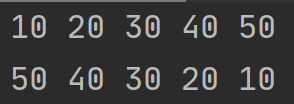
示例二:set存放自定义数据类型
#include <iostream>
using namespace std;
#include <set>
class Person
{
public:
Person(string name, int age)
{
this->m_Name = name;
this->m_Age = age;
}
string m_Name;
int m_Age;
};
class comparePerson
{
public:
bool operator()(const Person& p1, const Person &p2)
{
//按照年龄大小进行排序
return p1.m_Age > p2.m_Age;
}
};
void test01()
{
set<Person, comparePerson> s;
Person p1("刘备", 24);
Person p2("关羽", 28);
Person p3("张飞", 25);
Person p4("赵云", 21);
s.insert(p1);
s.insert(p2);
s.insert(p3);
s.insert(p4);
for (set<Person, comparePerson>::iterator it = s.begin(); it != s.end(); it++)
{
cout << "姓名: " << it->m_Name << " 年龄: " << it->m_Age << endl;
}
}
int main()
{
test01();
return 0;
}

八、map/multimap容器
8.1 map基本概念
简介:
1、map中所有元素都是pair
2、pair中第一个元素为key(键值),起到索引作用,第二个元素为value(实值)。
3、所有元素都会根据元素的键值自动排序。
本质:
map/multimap属于关联式容器,底层结构yoga二叉树实现。
优点:
可以根据key值快速找到value值。
map和multimap区别:
1、map不允许容器中有重复key元素;
2、multimap允许容器中有重复key元素。
8.2 map构造和赋值
功能描述:
对map容器进行构造和赋值操作。
函数原型:
构造:
- map<T1, T2> mp; //map默认构造函数:
- map(const map &mp); //拷贝构造函数
赋值: - map& operator=(const map &mp); //重载等号操作符
示例:
#include <iostream>
using namespace std;
#include <map>
void printMap(map<int,int>&m)
{
for (map<int, int>::iterator it = m.begin(); it != m.end(); it++)
{
cout << "key = " << it->first << " value = " << it->second << endl;
}
cout << endl;
}
void test01()
{
// 1、 map<T1, T2> mp; //map默认构造函数:
map<int,int>m;
m.insert(pair<int, int>(1, 10));
m.insert(pair<int, int>(2, 20));
m.insert(pair<int, int>(3, 30));
m.insert(pair<int, int>(4, 40));
printMap(m);
// 2、 map(const map &mp); //拷贝构造函数
map<int, int>m2(m); //拷贝构造
printMap(m2);
// 3、 map& operator=(const map &mp); //重载等号操作符
map<int, int>m3;
m3 = m2; //赋值
printMap(m3);
}
int main()
{
test01();
return 0;
}
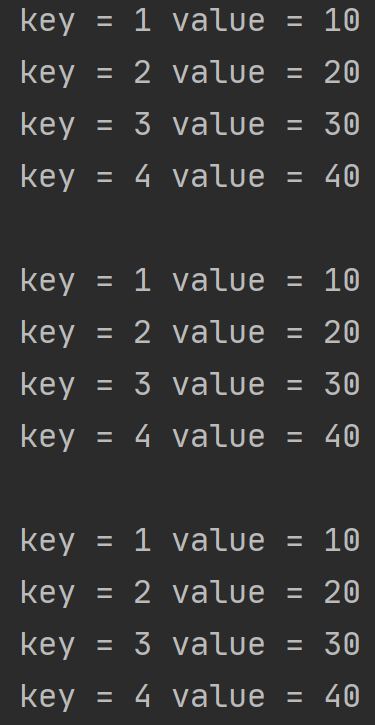
8.3 map大小和交换
功能描述:
统计map容器大小以及交换map容器。
函数原型:
- size(); //返回容器中元素的数目
- empty();//判断容器是否为空
- swap(st); //交换两个集合容器
示例:
#include <iostream>
using namespace std;
#include <map>
void printMap(map<int,int>&m)
{
for (map<int, int>::iterator it = m.begin(); it != m.end(); it++)
{
cout << "key = " << it->first << " value = " << it->second << endl;
}
cout << endl;
}
void test01()
{
map<int, int>m;
m.insert(pair<int, int>(1, 10));
m.insert(pair<int, int>(2, 20));
m.insert(pair<int, int>(3, 30));
// 1、 empty(); //判断容器是否为空
if (m.empty())
{
cout << "m为空" << endl;
}
else
{
cout << "m不为空" << endl;
// 2、 size(); //返回容器中元素的数目
cout << "m的大小为: " << m.size() << endl;
}
}
//交换
void test02()
{
map<int, int>m;
m.insert(pair<int, int>(1, 10));
m.insert(pair<int, int>(2, 20));
m.insert(pair<int, int>(3, 30));
map<int, int>m2;
m2.insert(pair<int, int>(4, 100));
m2.insert(pair<int, int>(5, 200));
m2.insert(pair<int, int>(6, 300));
cout << "交换前" << endl;
printMap(m);
printMap(m2);
cout << "交换后" << endl;
// 3、 swap(st); //交换两个集合容器
m.swap(m2);
printMap(m);
printMap(m2);
}
int main()
{
test01();
test02();
return 0;
}
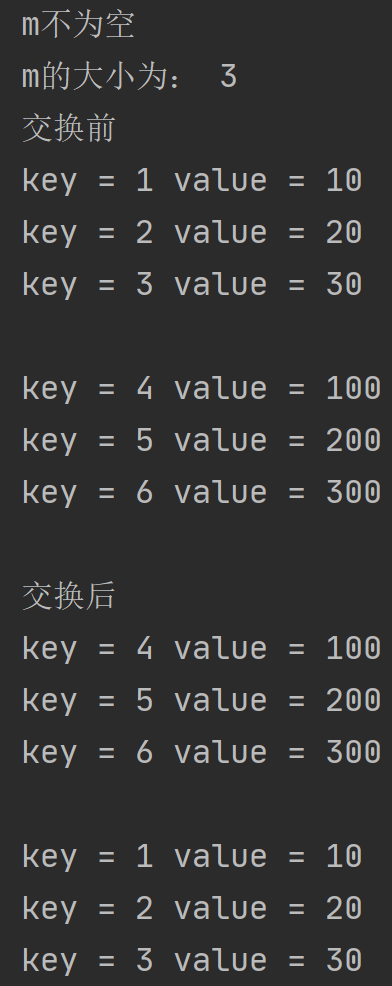
8.4 map插入和删除
功能描述:
map容器进行插入数据和删除数据。
函数原型:
- insert(elem); //在容器中插入元素。
- clear(); //清除所有元素
- erase(pos); //删除pos迭代器所指的元素,返回下一个元素的迭代器。
- erase(beg, end);//删除区间[beg,end)的所有元素 ,返回下一个元素的迭代器。
- erase(elem);//删除容器中值为key的元素。
示例:
#include <iostream>
using namespace std;
#include <map>
void printMap(map<int,int>&m)
{
for (map<int, int>::iterator it = m.begin(); it != m.end(); it++)
{
cout << "key = " << it->first << " value = " << it->second << endl;
}
cout << endl;
}
//map插入和删除
void test01()
{
map<int, int> m;
//第一种
m.insert(pair<int, int>(1, 10));
//第二种
m.insert(make_pair(2, 20));
//第三种
m.insert(map<int, int>::value_type(3, 30));
//第四种
m[4] = 40;
printMap(m);
// erase(pos); //删除pos迭代器所指的元素,返回下一个元素的迭代器。
m.erase(m.begin());
printMap(m);
// erase(key); //删除容器中值为key的元素。
m.erase(3);
printMap(m);
// erase(beg, end); //删除区间[beg,end)的所有元素 ,返回下一个元素的迭代器。
m.erase(m.begin(),m.end());
// clear(); //清除所有元素
m.clear();
printMap(m);
}
int main()
{
test01();
return 0;
}

8.5 map查找和统计
功能描述:
对map容器进行查找数据以及统计数据。
函数原型:
- find(key); //查找key是否存在,若存在,返回该键的元素的迭代器;若不存在,返回set.end();
- count(key); //统计key的元素个数
示例:
#include <iostream>
using namespace std;
#include <map>
//map查找和统计
void test01()
{
map<int, int>m;
m.insert(pair<int, int>(1, 10));
m.insert(pair<int, int>(2, 20));
m.insert(pair<int, int>(3, 30));
// 1、 find(key); //查找key是否存在,若存在,返回该键的元素的迭代器;若不存在,返回set.end();
map<int, int>::iterator pos = m.find(3);
if (pos != m.end())
{
cout << "找到了元素 key = " << (*pos).first << " value = " << (*pos).second << endl;
}
else
{
cout << "未找到元素" << endl;
}
// 2、 count(key); //统计key的元素个数
int num = m.count(3);
cout << "num = " << num << endl;
}
int main()
{
test01();
return 0;
}

8.6 map容器排序
学习目标:
map容器默认排序规则为按照key值进行从小到大排序,掌握如何改变排序规则
主要技术点:
利用仿函数,可以改变排序规则
示例:
#include <iostream>
using namespace std;
#include <map>
class MyCompare
{
public:
bool operator()(int v1, int v2)
{
return v1 > v2;
}
};
//map容器排序
void test01()
{
//默认从小到大排序
//利用仿函数实现从大到小排序
map<int, int, MyCompare> m;
m.insert(make_pair(1, 10));
m.insert(make_pair(2, 20));
m.insert(make_pair(3, 30));
m.insert(make_pair(4, 40));
m.insert(make_pair(5, 50));
for (map<int, int, MyCompare>::iterator it = m.begin(); it != m.end(); it++)
{
cout << "key:" << it->first << " value:" << it->second << endl;
}
}
int main()
{
test01();
return 0;
}























 281
281











 被折叠的 条评论
为什么被折叠?
被折叠的 条评论
为什么被折叠?








